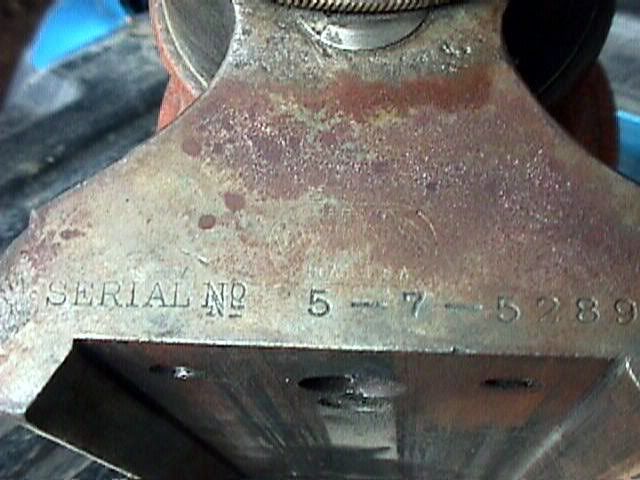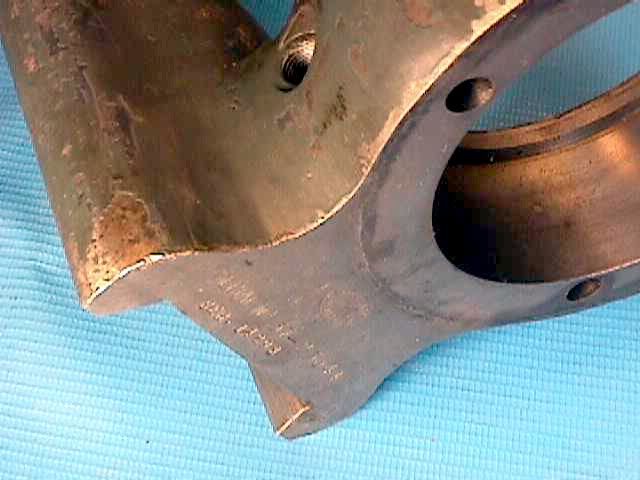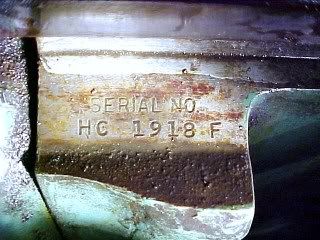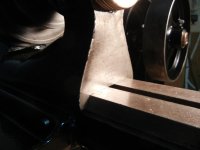L Vanice
Diamond
- Joined
- Feb 8, 2006
- Location
- Fort Wayne, IN
Many of you have seen the Hardinge serial number list on the Yahoo! Hardinge lathe and mill groups sites. I am not going to copy the table here, out of legal concerns. I am an engineer, not a lawyer, so I will play it safe. I thought my comments about the table and my own experiences would be of interest to readers of this forum.
The Hardinge 1936-1977 serial number file you have seen, headed "TM-UM-HC CHUCKERS," is actually the main serial number list that applies to almost all old Hardinge machines or tooling. The numbers are for items completed in January of the listed years.
The main number sequence goes back to about 1902 with about Number 1. I have seen early Cataract headstocks with no serial number, so it is not clear when they started numbering. I have only two date/serial data points before 1936, but December 31, 1927 was 5747 and December 31, 1935 was 12395. The 1936-1977 table gives numbers for machines built in January of the year listed. The apparent conflict in the January, 1936 number of 12309 probably reflects a variable lag between number assignment and actual completion of different machines. The highest serial number I have on a Chicago headstock is 11,141. I believe the 1931 switch from Chicago to Elmira was at a serial number between 11,141 and 12,309.
Many individual items had numbers in the early days, not just the headstocks. As far as I know, headstocks, tailstocks and beds on the Cataract machines each had their own numbers, not matching. Most Cataract tailstocks were not numbered. Hardinge trusted their interchangeability. I suspect that, early on, small items may have been numbered independently of the lathes,(in their own sequences), but I am not sure. I have a Cataract bench miller vise that is marked "No. 36" within the oval Hardinge Chicago stamp. I can't believe that this vise was the 36th item that Hardinge built, but it could have been the 36th vise. I have several thread cutting and chasing attachments with numbers in the 300's. Again, I suspect these items were not numbered in the same sequence with the lathe headstocks, but I don't really know. I have a pair of Cataract headstock and tailstock 2 inch riser blocks with matching numbers, and these are the only matching numbered items I have seen. I don't have the slide rest riser block that was supposed to be with them.
Note that Hardinge Cataract items almost always have the words "Serial No." stamped to the left of the number. Often, the headstock serial numbers will begin with the model number (37, 47, 57, 49 or 59) with a dash to separate it from the serial number. These serial numbers are placed in plain sight on the part. If an item like a slide rest has assembly numbers stamped on several components, they are more or less hidden after assembly and never say "Serial No." next to them.
The lathe serial number exceptions from the main sequence began in 1946, when the then-new dovetail bed DV, DSM and VBS lathes got their own number sequence. Then, in 1950, The new HLV and TFB lathes (5 inch beds) got their own sequence. In 1960, the "new model" DV-DSM-VBS and the HLV-H and TFB-H (7 inch beds) started over with yet more new number sequences. They did it again in 1962 with the "new style" chuckers, in 1963 with the ASM and in 1964 with the HSL. My information source ends in 1966, but I suppose the various NC and CNC model series got new numbers also.
The Machinery Dealers National Association sells a book titled Serial Number Reference Book for Metalworking Machinery (11th Edition) for $39.95 plus s&h. They sell the book by phone at (800) 872-7807.
I have not seen a copy, so I don't know if it has any more or less information than the chart on Yahoo. The Yahoo chart may have been copied from an old edition of the MDNA book. I got a copy of a 1936-1966 Hardinge list from a machine dealer about twenty years ago. That is where I got the information on the 1946 and later serial number ranges for the new model lathes. He made the copy from a book of numbers for many different brands of machine. I did not get a copy of the title page, so I don't know who published it. I suppose most all machine dealers have a copy, and the older editions would be of special interest to people who like old machines.
Thirty years ago, when I first started collecting Hardinge machines, I called the factory and they gave me a build year and model designation for a couple of old Elmira machines I had. I never asked the date of any of my many Chicago machines. I try not to bother them, so I don't know what they would do about a request these days. I know they don't have parts going back very far, but they may not have pitched all the serial number records yet.
Larry
[ 07-08-2006, 01:16 PM: Message edited by: L Vanice ]
The Hardinge 1936-1977 serial number file you have seen, headed "TM-UM-HC CHUCKERS," is actually the main serial number list that applies to almost all old Hardinge machines or tooling. The numbers are for items completed in January of the listed years.
The main number sequence goes back to about 1902 with about Number 1. I have seen early Cataract headstocks with no serial number, so it is not clear when they started numbering. I have only two date/serial data points before 1936, but December 31, 1927 was 5747 and December 31, 1935 was 12395. The 1936-1977 table gives numbers for machines built in January of the year listed. The apparent conflict in the January, 1936 number of 12309 probably reflects a variable lag between number assignment and actual completion of different machines. The highest serial number I have on a Chicago headstock is 11,141. I believe the 1931 switch from Chicago to Elmira was at a serial number between 11,141 and 12,309.
Many individual items had numbers in the early days, not just the headstocks. As far as I know, headstocks, tailstocks and beds on the Cataract machines each had their own numbers, not matching. Most Cataract tailstocks were not numbered. Hardinge trusted their interchangeability. I suspect that, early on, small items may have been numbered independently of the lathes,(in their own sequences), but I am not sure. I have a Cataract bench miller vise that is marked "No. 36" within the oval Hardinge Chicago stamp. I can't believe that this vise was the 36th item that Hardinge built, but it could have been the 36th vise. I have several thread cutting and chasing attachments with numbers in the 300's. Again, I suspect these items were not numbered in the same sequence with the lathe headstocks, but I don't really know. I have a pair of Cataract headstock and tailstock 2 inch riser blocks with matching numbers, and these are the only matching numbered items I have seen. I don't have the slide rest riser block that was supposed to be with them.
Note that Hardinge Cataract items almost always have the words "Serial No." stamped to the left of the number. Often, the headstock serial numbers will begin with the model number (37, 47, 57, 49 or 59) with a dash to separate it from the serial number. These serial numbers are placed in plain sight on the part. If an item like a slide rest has assembly numbers stamped on several components, they are more or less hidden after assembly and never say "Serial No." next to them.
The lathe serial number exceptions from the main sequence began in 1946, when the then-new dovetail bed DV, DSM and VBS lathes got their own number sequence. Then, in 1950, The new HLV and TFB lathes (5 inch beds) got their own sequence. In 1960, the "new model" DV-DSM-VBS and the HLV-H and TFB-H (7 inch beds) started over with yet more new number sequences. They did it again in 1962 with the "new style" chuckers, in 1963 with the ASM and in 1964 with the HSL. My information source ends in 1966, but I suppose the various NC and CNC model series got new numbers also.
The Machinery Dealers National Association sells a book titled Serial Number Reference Book for Metalworking Machinery (11th Edition) for $39.95 plus s&h. They sell the book by phone at (800) 872-7807.
I have not seen a copy, so I don't know if it has any more or less information than the chart on Yahoo. The Yahoo chart may have been copied from an old edition of the MDNA book. I got a copy of a 1936-1966 Hardinge list from a machine dealer about twenty years ago. That is where I got the information on the 1946 and later serial number ranges for the new model lathes. He made the copy from a book of numbers for many different brands of machine. I did not get a copy of the title page, so I don't know who published it. I suppose most all machine dealers have a copy, and the older editions would be of special interest to people who like old machines.
Thirty years ago, when I first started collecting Hardinge machines, I called the factory and they gave me a build year and model designation for a couple of old Elmira machines I had. I never asked the date of any of my many Chicago machines. I try not to bother them, so I don't know what they would do about a request these days. I know they don't have parts going back very far, but they may not have pitched all the serial number records yet.
Larry
[ 07-08-2006, 01:16 PM: Message edited by: L Vanice ]






